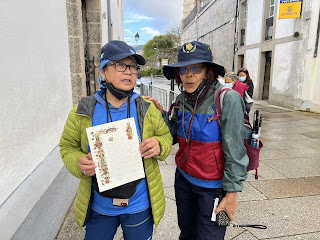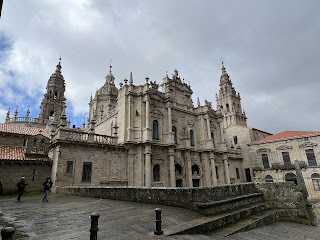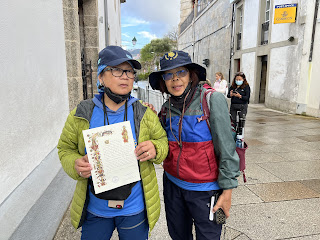Santiago de Compostela
Camino de Santiago (de Compostela) known as the way of Saint James.
Not only was I raised Catholic but I attended Catholic schools from kindergarten through high school. I’ve lived in and traveled throughout Europe numerous times but I have never explored the Camino de Santiago, even though it carries significant meaning for Christians
If you have never heard of the journey—Camino de Santiago (de Compostela), you might find this interesting.
Imagine a 2-6 week long journey, taken by more than 350,000 people (per year), from all over the world, in order to visit a sacred place, inside a grand Cathedral in Spain.
Welcome to the Camino the Santiago!—-The pilgrimage to shrine of the apostle of Saint James in northeastern Spain.
The Camino DeSantiago is a network of paths that Pilgrims take to visit the shrine of St. James the apostle, whose remains are believed to be stored in the main church, St. James in Santiago de Compostela. The church is located in north eastern Spain, in the region known as Galicia.
In all, there are a approximately a dozen caminos or paths.
Since the pope made a declaration in 1492, this is considered one of the three main pilgrimages in Christianity, alongside visits to Jerusalem and Rome. During the Middle Ages, pilgrims believed that making the journey would reduce their sentence in purgatory by 1/2. That’s not such a bad deal!
Although the Camino DeSantiago had virtually disappeared from the hearts of many, it experienced a revival in the late 20th century regaining its popularity of the medieval times. It is now a popular bucket list item.
Many of the women in my Solo Women Traveler Facebooks group have trekked the Camino DeSantiago.
The journey encompasses several different routes beginning in and including France, Spain, and Portugal. Each route has its own unique history, heritage, landscape, and charm. Sites along the way consist of green valleys, stone villages, medieval monasteries, vineyards, and some may even encounter the traditional Galician bagpipers.
There are many starting points for the routes because the original pilgrims would’ve commence their journeys from their own homes.
Most pilgrims arrive on foot to Santiago and come from nearby towns and cities. Some travel by bicycle and historically, some made the pilgrimage by horse or donkey. Like hiking the famous Appalachian Trail in the United States, many consider this a retreat from the hustle and bustle of daily life and often seek spiritual meaning. Those who start out alone often meet fellow travelers along the way and sometimes make lifelong friends as they chart their course. Some of the trails are more conducive to making friends.
The most popular route, and considered the most sacred, is the French Way that begins from the small town of St Jean Pied de Port in South eastern France. The longest of all, this hike is estimated to be 500 km or 300 miles. 2/3 of pilgrims takes The French Way.
The Portuguese Way is the second most popular trail and begins along the northern coastline of the city of Porto in northern Portugal.
The Northern Way begins in San Sebastian in Basque Country, and takes pilgrimages on a more off-the-beaten track trail through Cantabria and Asturias, and along side coastal villages and lush green towns.
The Primitive Route is the oldest and known as the original way. It’s one of the most challenging routes and offers an option to do the last 100 km into Santiago.
The English Way was popular among pilgrims from Britain and Ireland who were required to take a boat to one of the coastal cities of Ferrol or A Coruna to begin their journey. This is the shortest Camino route.
The French Way and many Spanish routes are on The UNESCO world heritage list.
For those who take the French Way, and some other routes, they face a 30-to 35 day journey and often walk for at least eight hours per day.
Many pilgrims begin their Camino in the Galician town of Sarria and walk the last 100 km of the French way, in about a week.
As I write about this, I reminded why this was never a bucket list item for me. I have never been a fitness buff and typically must get tricked into exercise.
Pilgrims are known by their signature walking sticks, gourds for drinking water from wells, a clock, a cloak, a pointy flappy hat, and a scallop shell attached with red yarn 🧶 to their backpacks. 🎒
Travelers stay in a variety of accommodations, mostly hostels/communal dormitory-style facilities.
Religious pilgrims are issued a “Camino de Santiago” passport and are guided to collect official passport stamps from all the major check points along the pilgrimage. If all qualifications are met, they will receive an official certification they have completed the Camino DeSantiago. At least 100,000 such certificates are issued each year. Walkers must walk for at least 100 kilometers and cyclists must cycle for at least 200 kilometers of their journey.
Every day at 10 AM, in front of the church of Santiago de Compostela, newly arriving pilgrims gather to celebrate and engage in the ritual of touching the scalloped shell in front of the church.
Every day at noon a mass is held for pilgrims and the names of all countries from which the pilgrims hail are read during the service.
During the last pre-Covid year, more than 345,000 pilgrims walked the Camino de Santiago. It will be interesting to see the numbers for 2022, now that international travel has resumed.




































